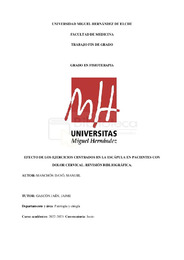Please use this identifier to cite or link to this item:
https://hdl.handle.net/11000/30089Full metadata record
| DC Field | Value | Language |
|---|---|---|
| dc.contributor.advisor | Gascón Jaén, Jaime | - |
| dc.contributor.author | Manchón Davó, Manuel | - |
| dc.contributor.other | Departamentos de la UMH::Patología y Cirugía | es_ES |
| dc.date.accessioned | 2023-11-09T11:37:17Z | - |
| dc.date.available | 2023-11-09T11:37:17Z | - |
| dc.date.created | 2023-06-16 | - |
| dc.identifier.uri | https://hdl.handle.net/11000/30089 | - |
| dc.description.abstract | Introducción: La cuarta causa principal de discapacidad en Estados Unidos entre los años 1990 y 2010 fue el dolor cervical. Su aparición es multifactorial y su tratamiento se diferencia en conservador y no conservador. Dentro del no conservador destaca el ejercicio terapéutico como uno de los tratamientos más eficaces. Objetivos: Revisar, a través de la literatura científica, el efecto de los ejercicios escapulares en pacientes con dolor cervical. Metodología: Se revisaron ensayos clínicos a partir de 2012 en las bases de datos Pubmed, Scopus, Web of Science y PEDro para determinar la efectividad de los ejercicios centrados en la escápula en pacientes con esta patología. Resultados: Se incluyeron quince estudios. Las medidas de resultado más recogidas fueron la intensidad del dolor y la disfunción cervical. El dolor se midió mediante la escala Numeric Pain Rating Scale (NPRS) o la Escala Visual Analógica (EVA) y la disfunción cervical mediante el Indice de Discapacidad de Cuello (NDI). Encontramos catorce artículos con mejora en el dolor y siete artículos con mejora en la disfunción cervical. Conclusiones: Resulta evidencia moderada que indica que el ejercicio centrado en la escápula es eficaz en el tratamiento del dolor y disfunción cervical. Existe evidencia baja en cuanto a cuál es el tiempo de intervención ideal, dosificación y tipo de ejercicio más eficaz. Existe evidencia baja en lo referido a identificar cuál es el mejor tratamiento o la mejor intervención para el dolor cervical. | es_ES |
| dc.description.abstract | Introduction: The fourth leading cause of disability in the United States between the years 1990 and 2010 was neck pain. Its onset is multifactorial and its treatment is differentiated into conservative and non-conservative. Within the non-conservative treatment, therapeutic exercise stands out as one of the most effective treatments. Objectives: To review, through the scientific literature, the effect of scapular exercises in patients with neck pain. Methodology: Clinical trials from 2012 were reviewed in Pubmed, Scopus, Web of Science and PEDro databases to determine the effectiveness of exercises focused on the scapula in patients with this pathology. Results: Fifteen studies were included. The most commonly collected outcome measures were pain intensity and cervical dysfunction. Pain was measured by the Numeric Pain Rating Scale (NPRS) or the Visual Analog Scale (VAS) and cervical dysfunction by the Neck Disability Index (NDI). We found fourteen articles with improvement in pain and seven articles with improvement in cervical dysfunction. Conclusions: There is moderate evidence that scapula-focused exercise is effective in the treatment of cervical pain and dysfunction. There is low evidence as to what is the ideal intervention time, dosage and type of exercise most effective. There is low evidence regarding identifying the best treatment or intervention for neck pain. | es_ES |
| dc.format | application/pdf | es_ES |
| dc.format.extent | 34 | es_ES |
| dc.language.iso | spa | es_ES |
| dc.publisher | Universidad Miguel Hernández de Elche | es_ES |
| dc.rights | info:eu-repo/semantics/openAccess | es_ES |
| dc.rights.uri | http://creativecommons.org/licenses/by-nc-nd/4.0/ | * |
| dc.subject | neck pain | es_ES |
| dc.subject | exercise | es_ES |
| dc.subject | scapula | es_ES |
| dc.subject | scapular stabilization | es_ES |
| dc.subject.other | CDU::6 - Ciencias aplicadas | es_ES |
| dc.title | Efecto de los ejercicios centrados en la escápula en pacientes con dolor cervical. Revisión bibliográfica. | es_ES |
| dc.type | info:eu-repo/semantics/bachelorThesis | es_ES |

View/Open:
TFG Manuel Manchón.pdf
797,31 kB
Adobe PDF
Share:
.png)
